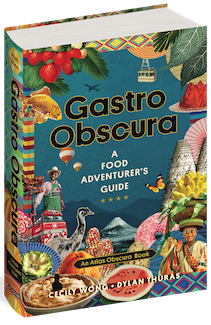AO Edited
Gastro Obscura
The Cuban Embassy's Hemingway Bar
When it opened during the final years of the embargo, all the drinks and cigars were free.
The Cuban Embassy on 16th Street in Washington, D.C. has repeatedly found itself on the front line of our foreign relations with the island nation over the past century. During the Cold War it was the site of several acts of anti-Castro terrorism. With the recent easing of tensions, a new mixological addition has accompanied the restored diplomatic relationship.
The Embassy has continued to reflect the tone of U.S.-Cuban relations. As tensions between the two countries thawed in 2011, the embassy offered up some “Daiquiri Diplomacy” and opened an exclusive bar on the top floor dedicated to Ernest Hemingway.
Hemingway, revered in both countries, once lived in Cuba and had a good relationship with Fidel Castro. In an interview with CNN, Ambassador Jose Ramon Cabanas described how as a child, “when we learn English in Cuba, we learn it through what [Hemingway] wrote, his pieces of literature.” The gesture was a peace offering of friendship.
The Hemingway bar has terracotta floors, traditional wooden fans, and is lined with photographs of the famous author. When it opened during the final years of the embargo, all the drinks and cigars were free because money couldn’t change hands between Americans and Cubans. Unfortunately, the bar isn’t open to the general public.
The diplomatic ties between the U.S. and Cuba didn’t always go down as smoothly as the cocktails served at the embassy’s bar. Though U.S.-Cuban relations prospered in the first half of the 20th century, the relationship deteriorated after the Cuban Revolution, eventually resulting in an embargo. Official diplomatic relations terminated in 1961 and the Cuban ambassador packed up and left Washington. Comrades from the Czechoslovakian Embassy thoughtfully served as house sitters over the next decade. During this tenure, the Post reported that, “shrubbery in front was damaged by Molotov cocktails allegedly hurled by Cuban veterans of the Bay of Pigs fighting.”
In 1974 a string of airplane hijackers demanded to be flown to Havana, and the two countries recognized the need for some base level of cooperation. The Cuban diplomats again returned to their DC location, but this time with limited privileges. The building was technically an Interest Section, described by The Atlantic as a “sort-of-embassy,” and the diplomatic staff weren’t allowed to travel beyond the Capital Beltway or the Dulles corridor.
The Cuban Interest Section building was bombed twice more by anti-Castro terrorists in 1978 and 1979. Luckily, no one was injured and the damage was limited to broken windows and a mangled air conditioner.
Architectural firm Macneil & Macneil designed the stately three-story embassy building in 1916, two decades after Cuba gained its independence. Before that, the Cuban diplomats occupied a smaller brownstone mansion at 1750 Massachusetts Avenue.
Know Before You Go
Unfortunately, the bar is not open to the public.
Community Contributors
Added by
Edited by
Plan Your Trip
The Atlas Obscura Podcast is Back!





















Follow us on Twitter to get the latest on the world's hidden wonders.
Like us on Facebook to get the latest on the world's hidden wonders.
Follow us on Twitter Like us on Facebook